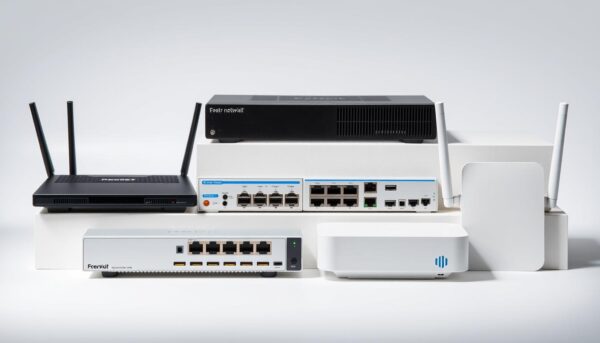✅ Last checked on
Ever wondered how your data moves smoothly across different networks? The secret is network gateways, the hidden heroes of our digital world. They act as translators, making sure different networks can talk to each other.
Network gateways are like bridges, connecting networks and making sure data gets where it needs to go. They translate protocols, so networks with different standards can communicate easily. This is key in today’s complex world, where many protocols and data types exist.
In the world of network communication, gateways are very important. They not only guide traffic but also protect against threats. As you read on, you’ll learn how these versatile tools are the backbone of modern networking.
Key Takeaways
- Network gateways enable communication between different networks
- They perform protocol translation for seamless data transfer
- Gateways facilitate traffic routing across diverse network ecosystems
- They provide essential security features at network boundaries
- Understanding gateways is crucial for modern network infrastructure
Understanding Network Gateway Fundamentals
Network gateways are key in today’s networking world. They manage all data traffic, both inside and outside a network. Let’s explore what makes them so important in our connected lives.
What is a Network Gateway
A network gateway connects different networks, letting data move between them. It acts as a translator, making sure networks with different protocols can talk to each other. It’s the first stop for data coming in or going out of a network.

Core Functions and Capabilities
Gateways do many important things:
- They route traffic between networks.
- They translate protocols for different networks.
- They act as proxy servers and firewalls.
- They gather data from various devices.
- They improve network visibility and security.
In big companies, gateways handle lots of connections. They are very useful for large organizations.
Protocol Translation Basics
One key job of a gateway is protocol translation. This lets networks with different protocols talk to each other. For instance, they can make sure IPv4 and IPv6 networks can communicate. They also change analog signals into digital VoIP signals. This makes sure data can move smoothly between different networks.
| Gateway Type | Primary Function |
|---|---|
| VoIP Gateway | Converts analog to digital signals |
| IoT Gateway | Aggregates sensor data |
| Cloud Storage Gateway | Translates storage requests |
| Email Security Gateway | Filters malicious content |
Types of Gateway Applications
Gateways are key in linking different networks and systems. Let’s look at various types and their roles in today’s tech world.
VoIP Gateways
VoIP gateways connect traditional phones with internet calls. They turn analog voice into digital data. This lets businesses use old phones with new internet call features.
IoT Gateways
IoT gateways connect smart devices to wider networks. They gather data, process it, and send it to the cloud. These gateways also protect data as it moves through networks.
Cloud Storage Gateways
Cloud storage gateways make cloud storage easy to use with on-premises systems. They let companies access cloud storage like it’s local. These gateways also help save storage space by compressing data.
Wireless Gateways
Wireless gateways, like cellular ones, make mobile and Wi-Fi connections possible. They are key for strong wireless networks in homes, offices, and public areas.
| Gateway Type | Primary Function | Key Benefit |
|---|---|---|
| VoIP Gateway | Connects traditional and IP-based phone systems | Cost-effective communication |
| IoT Gateway | Links smart devices to networks | Improved data management |
| Cloud Storage Gateway | Integrates on-premises and cloud storage | Seamless hybrid cloud adoption |
| Wireless Gateway | Enables wireless network access | Enhanced mobility and connectivity |
Gateway vs Other Network Components
It’s important to know how gateways are different from other network parts. We’ll look at the differences between gateways and routers, bridges, and firewalls.
Gateway vs Router Differences
Both gateways and routers work at the network layer. But they do different things. Gateways change protocols between networks. Routers, on the other hand, send data packets within a network.
Gateways change the way addresses are seen, like turning private to public IP addresses. Routers use special protocols to send packets quickly.
Gateway vs Bridge Comparison
Bridges and gateways do not do the same thing. Bridges just send data packets between segments without changing them. Gateways can change packets for different protocols, letting different networks talk to each other.
Gateway vs Firewall Distinctions
Gateways and firewalls both help with network security. But they do it in different ways. Firewalls make sure only certain things get in or out. Gateways help networks talk to each other, and they can also have security features.
For example, Timus’ Secure Web Gateway has web filters, checks SSL, and antivirus. This makes the network safer.
| Component | Primary Function | OSI Layer |
|---|---|---|
| Gateway | Protocol translation | Layer 5 |
| Router | Packet forwarding | Layer 3-4 |
| Bridge | Segment connection | Layer 2 |
| Firewall | Security enforcement | Layer 3-7 |

Network Gateway Architecture and Implementation
Network gateway architecture is key to modern connectivity. You can find gateways as physical devices or virtual solutions. Each is designed for different needs. The gateway implementation needs careful planning based on your network’s specific needs.
There are many ways to deploy gateways. Physical appliances are great for busy networks. Virtual gateways are flexible and scalable, perfect for cloud setups. Your choice depends on your network’s size, traffic, and security needs.
- Protocol translation modules
- Security features like firewalls and intrusion detection systems
- Traffic management tools
- Network address translation (NAT) capabilities
Choosing a gateway depends on your network size. Small businesses might choose simple solutions. Large companies need complex setups with many gateways for different network parts.
Setting up a network gateway means making it work with your current setup. This involves setting up routing, security policies, and network protocol compatibility. Keeping it updated is key for performance and security.
Gateway Security and Performance Features
Gateways are key in keeping networks safe and running smoothly. They offer important features for today’s network needs.
Multi-Protocol Support
Today’s gateways support many protocols, making communication between different networks easy. This makes data flow better across various systems, boosting network performance.
Network Visibility
Gateways give deep insights into network traffic. This lets admins see and manage data flow well. It’s key for spotting threats and improving gateway security.
Security Measures
Gateway security is vital to fight cyber threats. It includes:
- Firewall protection
- Intrusion detection systems
- Malware scanning
- Data encryption
These strong security tools block unauthorized access and data breaches. Such breaches can cost a company up to $3.86 million.
Performance Optimization
Gateways use several ways to boost network performance:
- Load balancing
- Traffic prioritization
- Caching mechanisms
These strategies make data transfer faster and networks more efficient.
| Feature | Benefit |
|---|---|
| Multi-protocol support | Seamless communication between diverse networks |
| Network visibility | Enhanced threat detection and management |
| Security measures | Protection against cyber threats and data breaches |
| Performance optimization | Improved data transfer speeds and network efficiency |
Conclusion
In this article, you’ve learned about the key role gateways play in today’s network world. These devices are crucial for connecting different networks smoothly. They help with everything from VoIP to IoT home networking.
Looking ahead, gateways will become even more important. They’re not just simple connections; they’re becoming smarter. They improve security, boost performance, and open up new tech possibilities.
Now you know how gateways work and why they’re essential. As tech keeps evolving, gateways will keep up. Understanding gateways prepares you for the future of network connectivity.